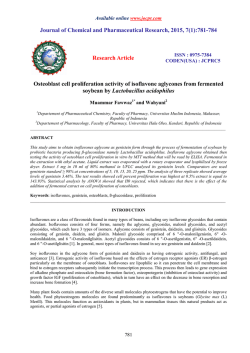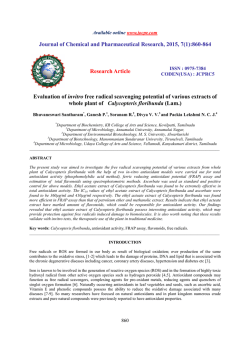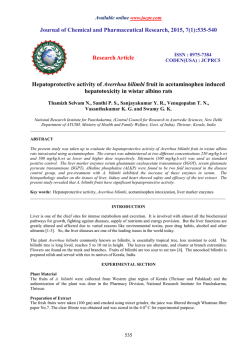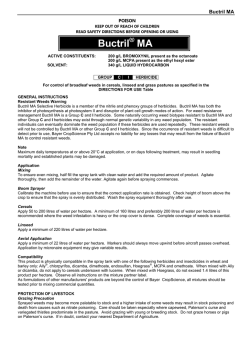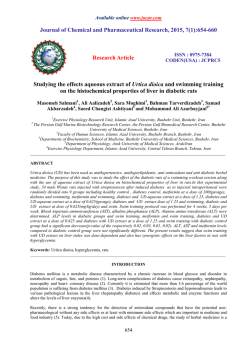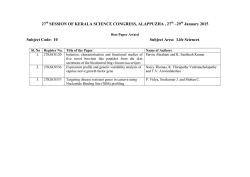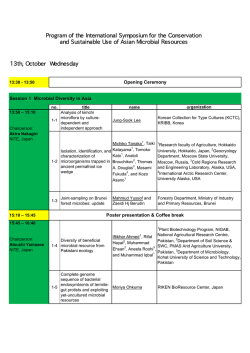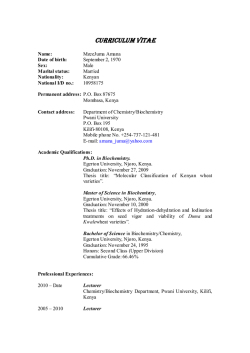
Phytochemical, proximate and antimicrobial screening of
Advances in Biochemistry & Biotechnology RESEARCH ARTICLE Open Access Bioscience Research Phytochemical, proximate and antimicrobial screening of neglected and underutilized Dioscorea species (Landrace) in Boki Local Government Area, Cross River State - Nigeria 1 Agbor R.B., 1Okoi E.P., 2Uno U.U and 3Iyam S.O 1 Department of Genetics and Biotechnology, University of Calabar, Calabar, Cross River State, Nigeria 2 Department of Biological Sciences, Cross River State College of Education Akamkpa, Nigeria 3 Department of Microbiology, University of Calabar, Calabar, Cross River State, Nigeria E-mail: [email protected] ABSTRACT This research work was carried out to determine the phytochemical, proximate composition and antimicrobial activity of Dioscorea sp obtained from Boki Local Government Area. The antimicrobial effect of Dioscorea sp plant was examined on some bacteria (Serratia, Pseudomonas, E. coli, Salmonella) and fungi (Penicillium, Candida, Aspergillus, Rhizopus ) species. The solvents used for the extraction of plants were water, ethanol, and methanol. The antimicrobial activity was performed by agar disc diffusion method. The result shows that all the microbial species used for this investigation were susceptible to the plant extracts. But the susceptibility of the microorganisms was mostly observed at 50% and 100% of the plant extract. The results of the phytochemical screening shows that tannin, alkaloids, flavonoids, glycosides, saponins, polyphenols and reducing compounds were of significantly high quantity in the tuber than the leaves of Dioscorea sp. The proximate constituent such as crude protein, crude fibre, ash, moisture, dry matter, ether extract and carbohydrate were significantly high (p<0.05) in the tuber than the leaves of the plant. Key words: Proximate, phytochemical, antimicrobial, Dioscorea, species Received: 21 January 2015 Accepted: 27January 2015 Available Online: 29 January 2015 Volume 1 | Issue 5 | 2015 Advances in Biochemistry & Biotechnology INTRODUCTION Naturally occurring substances are of plants, animals and mineral origin. They are organic substances and could be obtained in both primary and secondary metabolic process; they also provide a source of medicine since the earliest time. The plant kingdom has proven to be the most useful in the treatment of diseases and they provide an important source of all the world’s pharmaceuticals (Takagi et al. 1980). The most important of these bioactive constituents of plants are steroids, terpenoids, carotenoids, flavonoids, alkaloids, tannins and glycosides. Plants in all facet of life have served a valuable starting material for drug development (Feroz et al. 1993). Antibiotics or antimicrobial substances like saponins, glycosides, flavonoids and alkaloids etc are found to be distributed in plants, yet these compounds were not well established due to the lack of knowledge and techniques (Nagata et al., 1985). The phytoconstituents which are phenols, anthraquinones, alkaloids, glycosides, flavonoids and saponins are antibiotic principles of plants . From these phytoconstituents, saponins have been reported to exhibit hemolytic and foaming activity Shi et al., (2004), antifungal, anti-inflammatory, fungistatic, molluscidal (Zehavi and Segel 1986). Plants are now occupying important position in allopathic medicine, herbal medicine, homoeopathy and aromatherapy. Medicinal plants are the sources of many important drugs of the modern world. Many of these indigenous medicinal plants are used as spices and food plants; they are also sometimes added to foods meant for pregnant mothers for medicinal purposes (Okwu 1999, Okwu 2001). Many plants are cheaper and more accessible to most people especially in the developing countries than orthodox medicine, and there is lower incidence of adverse effects after use. These reasons might account for their worldwide attention and use (Ayitey-smith and Addae-Mensah 1977). The medicinal properties of some plants have been documented by some researchers (Gill and Saleem 1982, and Banso and Adeyemo 2007). This study looks into the fundamental scientific bases for the use of some medicinal plant seeds by determining the crude phytochemical constituents present in these plants. The yam species grows in the wild and in some forest area in Cross River State. The stem diameter ranges from 10-15 meters long, it has oval shape leaves with a leaf length range of 9-13.5cm, the leaf area of the plant ranges from 98.2cm2 – 136.8cm2, the leaf width ranges from 6.5cm -10.8cm. This species of yam grows with spines on its stems while the root of the plant produces large thorns that served as defense against predators. The thorns in the root grow in circle and form a heap. According to local farmers these species of plant is of two type, one eaten by humans and the other eaten by wild animals that can withstand the thorns. Harvesting is normally Volume 1 | Issue 5 | 2015 Advances in Biochemistry & Biotechnology done with the use of hand digger and the harvester wears thick gloves to avoid injuries. The plant grows well in both dry and wet season. MATERIALS AND METHODS Experimental laboratory The phytochemical and proximate analysis were carried out in the Department of Biochemistry while the antimicrobial analysis was carried out in the Department of Microbiology, University of Calabar, Calabar. The yam sp was obtained from the forest zone of Bashua village in Boki Local Government Area. The plant identification was done in the Herbarium unit of Botany Department, University of Calabar., University of Ibadan and Cross River State University of Technology. However, no proper identification has been made on the plant. Preparation of plant materials The plant samples were washed thoroughly, cut into small parts and then air-dried for 14 days. The dried plant samples were blended using Master chef electric blender (Model: MC-BL 1242) and the powdered samples were stored in an airtight sterile containers. Preparation of the plant extract Aqueous extraction Ten (10) gram of air dried powder was added to distilled water and boiled on slow heat for 2 hours. It was then filtered through 8 layers of muslin cloth and centrifuged at 5000g for 10minutes. The supernatant was collected. This procedure was repeated thrice. After 6 hours, the supernatant was collected at an interval of every 2 hours and was pooled together, concentrated to make the final volume one-fourth of the original volume. It was then autoclaved at 1210C and at 15 Ibs pressure and stored at 400C. Methanol extraction Ten (10) g of air-dried powder was taken in 100 ml of methanol in a conical flask, plugged with cotton wool and then kept on a rotary shaker at 190-220 rpm for 24 h. After 24 hours the supernatant was collected and the solvent was evaporated to make the final volume one fourth of the original volume (12) and stored at 40 C in airtight bottles. Phytochemical screening Chemical tests were carried out on the aqueous extract and on the powdered specimen using standard procedure to identify the constituents. Test for tannins: One gram of each powdered sample was separately boiled with 20 ml distilled water for five minutes in a water bath and was filtered while hot. 1 ml of cool filtrate was Volume 1 | Issue 5 | 2015 Advances in Biochemistry & Biotechnology distilled to 5 ml with distilled water and a few drops (2-3) of 10 % ferric chloride were added and observed for any formation of precipitates and any colour change. A bluishblack or brownish-green precipitate indicated the presence of tannins. Test for saponin: One gram of each powdered dried stain was separately boiled with 10ml of distilled water in a water bath for 10minutes. The mixture was filtered while hot and allowed to cool. The following tests were then carried out. Demonstration of frothing: 2.5 ml of filtrate was diluted to 10ml with distilled water and shaken vigorously for 2minutes (frothing indicated the presence of saponin in the filtrate). Demonstration of emulsifying properties: 2 drops of olive oil was added to the solution obtained from diluting 2.5 ml filtrate to 10 ml with distilled water (above), shaken vigorously for a few minutes (formation of a fairly stable emulsion indicated the presence of saponins). Test for phlobatannins: Deposition of a red precipitate when an aqueous extract of each plant sample was boiled with 1 % aqueous hydrochloric acid was taken as evidence for the phlobatannins. Test for terpenoids: Five milligram of each extract was mixed in 2 ml of chloroform. 3 ml of concentrated H2SO4 was then added to form a layer. A reddish brown precipitate colouration at the interface formed indicated the presence of terpenoids. Test for flavonoids: One gram of the powdered dried leaves of each specimen was boiled with 10 ml of distilled water for 5 minutes and filtered while hot. Few drops of 20 % sodium hydroxide solution were added to 1 ml of the cooled filtrate. A change to yellow colour which on addition of acid changed to colourless solution depicted the presence of flavonoids. Test for cardiac glycosides: Five milligram of each extract was treated with 2 ml of glacial acetic acid containing one drop of ferric chloride solution. This was underplayed with 1ml of concentrated sulphuric acid. A brown ring at the interface indicated the deoxysugar characteristics of cardenolides. A violet ring may appear below the ring while in the acetic acid layer, a greenish ring may be formed. Test for combined anthraquinones: One gram of powdered sample of each specimen was boiled with 2 ml of 10 % hydrochloric acid for 5 mins. The mixture was filtered while hot and filtrate was allowed to cool. The cooled filtrate was partitioned against equal volume of chloroform and the chloroform layer was transferred into a clean dry test tube using a clean pipette. Equal volume of 10% ammonia solution was added into the chloroform layer, shaken and Volume 1 | Issue 5 | 2015 Advances in Biochemistry & Biotechnology allowed to separate. The separated aqueous layer was observed for any colour change; delicate rose pink colour showed the presence of an anthraquinone. Test for free anthraquinones: Five milligram of chloroform was added to 0.5 g of the powdered dry seeds of each specimen. The resulting mixture was shaken for 5 mins after which it was filtered. The filtrate was then shaken with equal volume of 10 % ammonia solution. The presence of a bright pink colour in the aqueous layer indicated the presence of free anthraquinones. Test for carotenoids: One gram of each specimen sample was extracted with 10 ml of chloroform in a test tube with vigorous shaking. The resulting mixture was filtered and 85 % sulphuric acid was added. A blue colour at the interface showed the presence of carotenoids. Test for reducing compounds: To about 1 g of each sample in the test tube was added 10 ml distilled water and the mixture boiled for 5 mins. The mixture was filtered while hot and the cooled filtrate made alkaline to litmus paper with 20 % sodium hydroxide solution. The resulting solution was boiled with an equal volume of Benedict qualitative solution on a water bath. The formation of a brick red precipitate depicted the presence of reducing compound. Test for alkaloids: One gram of powdered sample of each specimen was separately boiled with water and 10ml hydrochloric acid on a water bath and filtered. The pH of the filtrate was adjusted with ammonia to about 6-7. A very small quantity of the following reagents was added separately to about 0.5 ml of the filtrate in a different test tube and observed. Proximate composition analyses of Dioscorea sp: Fats contents were determined by using AOAC (1990) 22.034 and protein content AOAC, PN-75/A-04018. Crude fiber was determined by treating oil-free sample by sulphuric acid (0.26 N) and potassium hydroxide (0.23 N) solution in refluxing systems, followed by oven drying and muffle furnace incineration (AOAC, 1984). For the determination of ash content 3 g of grounded Dioscorea sp leave and tuber were taken in desiccated china dishes. The samples were then charred and ashed by using muffle furnace in two shocks first at 5500C for 30 min and then at 8500C for 30 min. The dishes were removed and when cool to room temperature each dish was reweighed containing white appearing ash. By difference the weight of ash was calculated. Where (W2- W) x100 Ash (%) = W 1- w W2 = Weight in gm of the dish with the ash Volume 1 | Issue 5 | 2015 Advances in Biochemistry & Biotechnology W = Weight in gm of empty dish W1 = Weight in gm of the dish with the dried material taken for test. Moisture Contents were determined according to the method used by Khan and Kulachi (2002). For this purpose leaves were taken and their fresh weight was determined. Then they were placed in oven at 720C for 48h and were again weighted. The moisture content was determined according to the formula: Weight of fresh seeds-weight of dry seeds x 100 Moisture content (%) = Weight of fresh The digestible carbohydrates were calculated by difference. Total energy values were calculated by multiplying the amounts of protein and carbohydrate by the factor of 4 kcal/g and lipid by the factor of 9 kcal/g as described by Bazi Yabani et al. (2009). Antimicrobial activity of the plant Antimicrobial activity was examined for aqueous, ethanol and methanol extracts from leaves and tuber of Dioscorea sp. The microbial isolates were collected from University of Calabar Teaching Hospital (UCTH). The antibacterial activity of Dioscorea sp plant extract was evaluated by disc diffusion method (Chung et al. 1990). Muller Hinton agar medium was prepared and poured into the petri dishes and allowed to solidify. Then it was inoculated with a swab of culture and spread throughout the medium uniformly with a sterile cotton swab. A sterile filter paper disc was prepared and dipped with plant tuber and leaf extracts (water, ethanol, methanol) at concentration of 25%, 50% and 100% and then placed on the surface of agar plates. The test was performed in triplicate and their efficiency was determined by measuring the diameter of zone of inhibition around the well Statistical analysis Data collected for the antimicrobial activities of the plant were subjected to a 2x3x4 factorial CRD experiment and significant means were separated using Least Significant difference (LSD) Test at 5% probability level. The data for proximate and phytochemical analysis of the plant were subjected to Complete Randomized Design. Volume 1 | Issue 5 | 2015 Advances in Biochemistry & Biotechnology Plate 1: Tuber of Kekor (Dioscorea sp) Plate 2: Kekor (Dioscorea sp) root and stem with sharp thorns Volume 1 | Issue 5 | 2015 Advances in Biochemistry & Biotechnology Plate 3: Leaves of Kekor (Dioscorea sp) Plate 4: Stem of Kekor (Dioscorea sp) Volume 1 | Issue 5 | 2015 Advances in Biochemistry & Biotechnology Plate 5: Harvesting of yam tuber of Kekor (Dioscorea sp) RESULTS AND DISCUSSION Phytochemical properties of Dioscorea sp The alkaloids, polyphenols and reducing compounds in the leaves of Dioscorea sp were significantly higher (p<0.05) than those of the tuber of the plant. Saponins, tannins in the leaves and tuber were not significantly different. The flavonoids and glycosides in the tuber of Dioscorea sp were significantly higher (p<0.05) than those of the leaves of the plant. Phytochemicals are non-nutritive plant chemicals that have protective or disease preventive properties. These bioactive compounds are naturally found in food, leaves, stem and roots or other parts of plants that interplay with nutrients and dietary fiber to protect them (Ekpo et al., 2012). The presence of alkaloids, polyphenols, reducing compounds, saponins, tannins, flavonoids, and glycosides in significantly high amount in both leaves and tuber of Dioscorea sp is an indication that the plant possesses medicinal properties that could be used in the abetment of infectious diseases (Table 1). Traditionally saponins have been extensively used as detergents, as piscicides and molluscicides, in addition to their industrial applications as a foaming and surface active agent and also have beneficial health effects Shi et al., (2004). However, with the significantly high amount of flavonoid in the tuber of the plant, Dioscorea sp can then be seen as a good dietary source for flavonoid. Alkaloids in the leaves of Dioscorea sp were significantly higher (P<0.05) than those of the tuber. This implies that extraction of high Volume 1 | Issue 5 | 2015 Advances in Biochemistry & Biotechnology amount of alkaloid in the plant can be achievable using the leaves. Alkaloid is an important bioactive compound that could be used in stimulating the nervous system as well as lowering blood pressure in patients. Okaka et al., (1992) reported that high levels of alkaloids in foods could cause gastro-intestinal upset and neurological disorders. However, based on the result of this study the tuber of Dioscorea sp with low level of alkaloids could be of more medicinal use than the leaves. Tannins have been reported by Osuntogun et al., (1987) to affect the nutritive value of food products by forming complex with protein (both substrate and enzyme) therefore inhibiting digestion and absorption. Tannins in leaves and tuber of Dioscorea sp were found to be of considerably equal amount. Proximate composition of Dioscorea sp The proximate composition of the tuber such as crude protein, crude fibre, ether extract, ash, dry matter and carbohydrate contents were significantly higher (p<0.05) than those of the leaves (Table 2). The significantly high amount of carbohydrate and crude protein in the plant is an indication that consumers will gain energy needed for the biochemical and biological reactions with the body systems which would promote growth and development. Crude fibre content in the plant was found to be significantly high (p<0.05) in the tuber than the leaves this could be due to the presence of waxy substances. Alabi et al., (2005) also found that P. biglobosa had high amounts of lipid, protein, carbohydrate, soluble sugars and ascorbic acid. Interestingly, the amount of protein in the tuber of Dioscorea sp would play an important part in human nutrition. Protein not only support growth but is also important for maintenance and repair of body tissues. Table 2: Proximate composition of the tuber and leaves of Dioscorea sp Parameters Crude protein (%) Moisture (%) Crude fibre (%) Ether extract (%) Ash (%) Dry matter (%) Carbohydrate (%) Leaves 11.80b±0.02 8.00a±0.02 19.20b±0.07 4.5b±0.01 2.67b±0.02 92b±0.11 26.3b±0.0 Tuber 23.65a±0.02 5.00a±0.01 23.19a±0.06 7.0a±0.04 3.18a±0.01 95a±0.12 76.8a±0.03 Means with the same case letter along the horizontal arrays indicate no significant difference (p>0.05 Volume 1 | Issue 5 | 2015 Advances in Biochemistry & Biotechnology Effect of concentration of Dioscorea sp on zones of inhibition of microorganisms It has been observed over time that different ethanol, water, and methanol extract of the leaves have demonstrated in-vitro antibacterial activities against E.coli, Staphylococcus, Pseudomonas, Salmonella, Streptobacillus and Streptococcus. The result of this study shows that the zone of inhibition of bacteria using Pseudomonas sp at 25% of the extract and Salmonella sp at 100% of the extract had significantly high zones of inhibition with no significant difference (P>0.05) between them (Table 3). This was followed by E.coli (at 25%, 50%, 100%), Pseudomonas sp at 50%, 100% and Serratia sp at 100% had no significant difference (P>0.05), this was also followed by Salmonella sp at 25% of the extract while Serratia sp at 25% and 100% of the extracts produces the lowest zones of inhibition. Agatemor (2009) reported that the ethanol extract of Ocimum gratissium showed antibacterial activity against S. aureus and E.coli. In Fig 2 Proteus sp produces a high zone of inhibition at 100% of the extract followed by 50% and 25%. Serratia sp at 25% of the extract was found to produce a high zone of inhibition followed by 100% and 50% respectively. Pseudomonas sp at 25% and 100% produces no significant difference (p>0.05) but had a high zone of inhibition than 50% of the extract. E. coli at 50% and 25% produces a high zone of inhibition followed by 100% of the extract. Salmonella sp had a high zone of inhibition at 100% of the extract, followed by 25% of the extract while 50% of the extract produces no zone of inhibition. In Fig 1. The methanolic and ethanolic extract of Dioscorea sp were found effective in the inhibition of bacteria growth than the cold and hot water extract. The tuber methanolic extract produces significantly high (p<0.05) zone of inhibition using Penicillium sp followed by tuber methanolic extract and leaf methanolic extract that had no significant difference (p>0.05), this was then followed by the leaf ethanolic extract while leaf hot water extracts had the lowest zone of inhibition. The leaf cold water extract, tuber hot and cold water extract had no zones of inhibition. It was observed that the Candida sp using tuber ethanolic extract produces a high zone of inhibition followed by the tuber methanolic extract, also followed by leaf ethanolic extract, and tuber hot water extract that had no significant difference (p>0.05) between them. This was also followed by the leaf methanolic extract, then tuber, cold water extract and the leaf hot water extract. The result obtained using Aspergillus sp on leaf ethanolic extract and tuber methanolic extract of Dioscorea sp with no significant difference (p>0.05). This was also followed by tuber cold water extract and leaf methanolic extract that had low zone of inhibition. It was observed the Rhizopus sp on tuber methanolic extract and leaf ethanolic extract plate of kekor produces significantly high zones of inhibition followed by tuber ethanolic extract, leaf methanolic and leaf hot water extract with no significant difference (p>0.05) which was also followed by the Volume 1 | Issue 5 | 2015 Advances in Biochemistry & Biotechnology tuber hot and tuber cold water extract. The leaf cold water produces zero zones of inhibition. The observed difference of the plant extracts may be as a result of insolubility of the bioactive components in the various solvent or the presence of the inhibitors to the antimicrobial components Okigbo and Ogbonnanya (2006). Dioscorea sp with the numerous inhibitory properties could be regarded as an important food crop that could be utilized as antifungal agent. Table 3: Zone of inhibition of bacteria sp using Kekor (Dioscorea sp) extract Concentration Serratia sp Pseudomonas E.coli Salmonella sp Of extract sp e 25% 0.24 ±0.01 1.67a±0.02 1.40b±0.02 0.78c±0.01 50% 0.63d±0.02 1.06b±0.01 1.27b±0.02 NZ b b b 100% 1.52 ±0.01 1.16 ±0.01 1.39 ±0.01 1.68a±0.01 LSD value = 0.11 3.5 Zones of inhibition (mm) 3 2.5 2 1.5 1 0.5 0 Proteus sp Serratia sp Pseudomonas sp Fig.1: Effect of Dioscorea sp extract on bacterial activity Key: LHW-Leaf hot water., LCW- Leaf cold water., LETH- Leaf Ethanol., LMETH- Leaf methanol., THW- Tuber hot water., TCW- tuber cold water., TETH- Tuber ethanol., TMETH- Tuber Methanol Volume 1 | Issue 5 | 2015 Zones of inhibition (mm) Advances in Biochemistry & Biotechnology 1.8 1.6 1.4 1.2 1 0.8 0.6 0.4 0.2 0 25% 50% 100% Fig.2: Effect of extract concentrations on bacterial activity Table 4: Zone of inhibition of fungi species using Kekor (Dioscorea sp) extract. Concentration Penicillium sp Candida sp Aspergillus sp Rhizopus sp Of extract 25% NZ 1.60a±0.02 0.78b±0.02 1.26c±0.01 50% 1.26d±0.02 1.15b±0.01 0.66b±0.02 1.53a±0.01 100% 2.25b±0.01 2.8a±0.01 1.50a±0.01 2.03b±0.01 LSD value = 0.09., NZ- No Zones Volume 1 | Issue 5 | 2015 Advances in Biochemistry & Biotechnology Table 1: Phytochemical composition of Dioscorea sp Means with the same case letter along the horizontal array indicate no significant difference (p>0.05). SAMPLES Alkaloids Saponins Tannins Flavonoids Glycosides Polyphenols Leaves Tuber 2.20a±0.02 1.40b±0.01 0.40a±0.01 0.20a±0.01 0.51a±0.02 0.42a±0.03 3.0b±0.01 3.6a±0.01 1.57b±0.03 2.16a±0.02 17.65a±0.02 14.67b±0.01 Reducing compounds 27.88a±0.01 26.46b±0.02 Table 5: Zones of inhibition of fungi species Fungi species LHW LCW LETH LMETH THW TCW TETH TMETH Pencillium 1.53d±0.02 NZ 2.03c±0.01 2.44b±0.02 NZ NZ 2.37b±0.02 2.87a±0.02 Candida 1.08f±0.01 NZ 2.27c±0.02 1.59d±0.01 2.17c±0.02 1.40e±0.02 3.30a±0.03 2.99b±0.02 Apergillus NZ NZ 2.33a±0.01 0.74d±0.01 NZ 0.90c±0.01 1.97b±0.02 1.9b±0.01 Rhizopus 1.49b±0.01 NZ 3.09a±0.03 1.42b±0.02 1.06c±0.01 1.10c±0.01 1.54b±0.01 3.14a±0.01 LSD0.05 = 0.13., NZ - No zones Key: LHW-Leaf hot water., LCW- Leaf cold water., LETH- Leaf Ethanol., LMETH- Leaf methanol., THW- Tuber hot water., TCW- tuber cold water., TETH- Tuber ethanol., TMETH- Tuber Methanol Volume 1 | Issue 5 | 2015 Advances in Biochemistry & Biotechnology Zones of inhibition (mm) 3 2.5 2 1.5 1 0.5 0 25% 50% 100% Fig. 3: Effect of extract concentrations on fungi activity Key: LHW-Leaf hot water., LCW- Leaf cold water., LETH- Leaf Ethanol., LMETHLeaf methanol., THW- Tuber hot water., TCW- tuber cold water., TETH- Tuber ethanol., TMETH- Tuber Methanol Conclusion The phytochemical contents of the stem, leaves, root and bark of plant serve as supplements for food and also have the potential to improve the health status of its users as a result of the presence of various compounds vital for good health. Their fiber content provides bulk in the diet and this helps to reduce the intake of starchy foods, enhances gastrointestinal function, prevents constipation and may thus reduce the incidence of metabolic diseases like maturity onset diabetes mellitus and hypercholesterolemia. Some of the plants are also potent antibiotics, antihypertensives and blood building agents and also improves fertility in females when used. REFERENCES Abubakar, H.N, Olayiwola, I.O., Sanni. S. A. and Idowu, M. A. (2010). Chemical composition of sweet potato (Ipomea batatas Lam) dishes as consumed in Kwara State, Nigeria, International Food Research Journal 17: 411-416. Ajayi I. A., Ajibade O. and Oderinde R. A. (2011). Preliminary Phytochemical Analysis of some Plant Seeds, Journal of Chemical Sciences, 1(3): 58-62 Alabi D.A., Akinsulire O.R. and Sanyaolu M.A. (2005).Qualitative determination of chemical and nutritional composition of Parkia biglobosa (Jacq.) Benth. African Journal of Biotechnology, 4(8): 812-815 Volume 1 | Issue 5 | 2015 Advances in Biochemistry & Biotechnology AOAC, 1980. Official Methods of Analysis (13th edition). Association of Official Analytical Chemists, Washington, DC, USA, 211-222. Arvind J. M., Ravi A., Alka C., and Prakash Z. (2010) Preliminary Phytochemical screening of Ipomoea obscura (L) -A hepatoprotective medicinal plant, International Journal of Pharmacology and Technology Research 2 (4), 2307-2312, Ayitey-Smith E and Addae-Mensah I (1977). A preliminary pharmacological study Winnine: A piperine type of alkaloid from the roots of Piper guineense. West African Journal of Pharmacology and Drug Research. 4: 7-8. Banso A and Adeyemo SO (2007). Evaluation of antibacterial properties of tannins isolated from Dichrostachys cinerea, African Journal of Biotechnology. 6(15): 1785-1787. Chung K.T., Thomarson W.R and Wu Tuan C.D (1990). Growth inhibition of selected food borne bacterial Particularia listeria monocytogens of plant extracts. Journal of Applied Bacteriology., 69: of cooking on the nutritional and phytochemical components 498509. Ekpo I.A., Agbor R.B., Osuagwu, A.N., Ekanem B.E., Okpako E.C., and Urua I.S (2012). Phytochemical and comparative studies of the stem bark and root of Xylopia aethiopica (dunal.) A. Rich. World Journal of Biological Research, 5(2): 41-44. Ezeocha V.C, Ojimelukwe, P.C. and Onwuka G.I. (2012). Effect of trifoliate yam (Dioscorea dumetorum), Global Advanced Research Journal of Biochemistry and Bioinformatics, 1(2), 26-30 Feroz, M., R. Ahmed, S.T.A.K. Sindhu and A.M. Shahbaz. 1993. Antifungal activities of saponins from indigenous Medicago sativa roots. Pakistan. Veterinary Journal, 13: 14. Francis G., Kerem Z., Makkar H.P.S and Becker K (2002). The biological action of saponins in animal system: a review; British Journal of Nutrition, 88(6): 587-606. Galeotti, A. (2008), “Talking, Searching and Pricing” (Mimeo, University of Essex). Gill M.A and Saleem A. (1982). Screening of genetic stock of sugar cane against Red Rot disease. Pakistan Journal of Botany, 15: 117-119 Harbone, J.B., 1973. Phytochemicals methods. London. Chapman and Hill. Nagata K., Tajiro T., Estsuji H., Noboyasu E., Shunichi M and Chikao N (1985). Comellindin antifungal saponins isolated from camellia Japonica. Agricultural and Biological Chemisry., 49: 1181-1186. Okwu DE (1999). Flavouring properties of spices on cassava Fufu. African Journal of Roots Tuber Crops 3(2): 19-21. Okwu DE (2001). Evaluation of the chemical composition of indigenous spices and flavouring Agents. Global Journal of Pure and Applied Science 7(3): 455- 459. Volume 1 | Issue 5 | 2015 Advances in Biochemistry & Biotechnology Pearson, D., 1970. The Chemical Analysis of Foods (7th edition). Churchhill Livingstone, Edinburgh, 6-25. Satyavati, G.V., A.K. Gupta and N. Tandon, 1987. Medicinal plants of India, Indian Council of Medical Research, New Delhi, India. Senanayake S.A., Ranaweera K.K., Bamunuarachchi A. and Gunaratne A. (2012). Proximate analysis and phytochemical and mineral constituents in four cultivars of yams and tuber crops in Sri Lanka, Tropical Agriculture Research and Extension, 15(1: 33-37 Shi J., Arunasalam K., Yeung D., Kakuda Y., Mittal G and Jiang Y (2004). Saponins from edible legumes: Chemistry, processing and health benefits, Journal of Medicinal Food 7: 67-78. Sofowora A. (1993). Screening plants for bioactive agents. In Medicinal plants and traditional medicine in Africa (2nd ed). Spectrum books Ltd., Sunshine House, Ibadan, Nigeria, 289. Takagi K., Hee P.E and Histoshi S (1980). Anti-inflammatory activities of hedergenin and crude saponin from Saccindus mukorassi. Chemical Bullentin, 28:118. Zehavi U.M.L and Segel (1986). Fungistatic activity of saponin A from Styrex officinalis L. on plant pathogens. Journal of Phytopathology, 116, 338-343. Volume 1 | Issue 5 | 2015
© Copyright 2026
